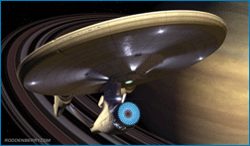3-D Lenticular Star Trek Review
3 min readRoddenberry Productions introduced a new Star Trek product at Comic Con this summer and for those who enjoy art, the three lenticular prints of Star Trek ships are a “must have.”
Adam “Mojo” Lebowitz, co-creator of the original Ships of the Line calendar series, thought it would be a great idea to use lenticular printing to make hi-resolution, lenticular 3-D art. Three different ships were chosen: the USS Enterprise 1701 (no bloody A,B,C or D!), the most recent Enterprise from Star Trek XI, and for Star Trek: The Next Generation fans, a shot of the Enterprise-E and a Borg Cube from Star Trek: First Contact.
Most people are familiar with lenticular images. Two or more separate images are used when making a lenticular image, with each image first being cut into strips using a computer graphics program, and then the strips being joined together, or interlaced, by alternating strips from the first and second images. Then, a transparent plastic layer is put on top of the new image. The plastic layer is made of separate ridges called lenticles. Half of the lenticles lean to the left, half to the right and overall, they will alternate left, right, left, right. The finished product will therefore show one image when one views the image from the left, and a different image when one looks from the right.

The three Star Trek ships are crisp and sharp, and simply spectacular. No 3-D glasses are needed to view the 3-D effects of these photos. Beginning with the Enterprise 1701, as any old-school fan would, one notices immediately that the saucer part of the ship seems to jump off of the image, with two blue phaser shots arcing off to the right. The right-most nacelle emphasizes the depth, being behind the saucer and a close observation of the starfield shows stars in different layers of space, further emphasizing the depth.

Next up is the Enterprise rising up from Saturn. In this exquisite shot, it really DOES appear that the ship is rising up from the planet and coming out of the print into the room. One can almost touch the ship. The seemingly semi-transparent rings of Saturn are on the left side of the image, at a different angle in the background behind the ship, which enhances the perception of depth. The mass of Saturn, with golden bands of color, shimmers on the right side of the image.

The Star Trek: First Contact image has several layers of depth to it, beginning with a blue Earth and a starfield in the background. The Earth is detailed, with a small band of atmosphere, and colorings that hint at land masses and bodies of water beneath clouds.
The next layer on the First Contact image is that of an enormous Borg Cube. There are various spots on the Cube that are lit, hinting at the life inside of the Cube. The upper right part of the Borg Cube is lighter in color and the intricate detail of the outside of the Borg Cube can be clearly seen. A green energy beam emerges from the upper part of the Borg Cube and appears to get closer to the viewer as it reaches the bottom left side of the image.
Finally, the last layer of the First Contact image is that of the Enterprise-E itself. One of the nacelles, its underside lit in green, appears to be coming out of the image into the room towards the viewer.
Those who purchase these images will face a dilemma. The automatic impulse is to have all three framed as they are beautiful prints that would grace any room. But each image has something on the back too; starship schematics, tactical displays and archival information.
The set of three lenticular prints sells at Roddenberry.com for $39.95 for the set. Each print sells individually for $14.95. To get a sense of how they would look in 3-D, pick up a pair of 3D glasses and head over to Darth Mojo’s blog.






